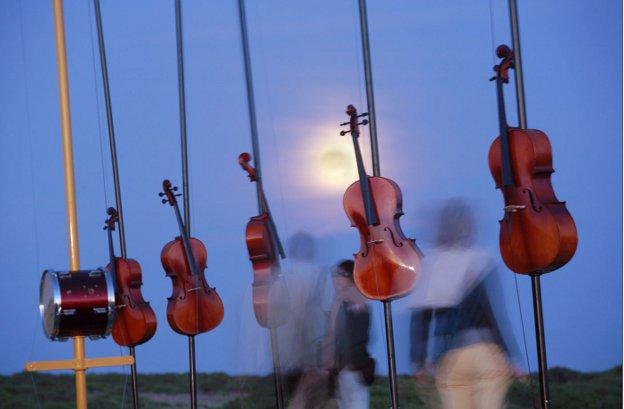You wait for a coach outside the Lanternhouse in Ulverston, which takes you twenty minutes out of the town and onto the hills overlooking Morecambe Bay – quite a spectacular place and a view to die for. The hills overlook Windscale so it’s a view you quite possibly could die for.
Here you discover Harmonic Fields – a huge sound installation created by Pierre Sauvageot, who has a long track-record in creating music on the streets: peripatetic choirs, orchestras where the audience play the ‘instruments’, brass bands who accompany the monthly testing of sirens in Marseilles.
Harmonic Fields presents a wide variety of instruments that rely on the wind to play them. The installation covers a large area of ground and it’s arranged in different categories of instrument. There’s a walkway with large bamboo poles on either side. Each bamboo pole has had notches carved into it so that they sound like flutes as the wind blows through them – a subtle and, at times, unearthly sound.
Further along are a patch of Balinese scarecrows – bamboo bird-table style structures on poles where the wind catches a small wheel which then causes a little figure to bob up and down hitting the table surface. In the strong Cumbrian winds the figures are bobbing up and down like the clappers; many have in fact been blown to bits by the strong gusts.
There are a series of drums salvaged from kits that you can put your head inside. There is a long wire connected at either side to drums which act as a sound box for the wire which is being whipped around by the wind. Membranes vibrate, sticks on wheels blow against bells, violins amplify their breeze-agitated strings. There’s nothing digital here, just a development of age-old instruments like Aeolian Harps, wind-chimes and bull-roarers.
Visually it looks terrific on the hill-side. Lots of wheels rushing round, things on tall poles and subtle sculptural interventions to the basic shapes of instruments. The instruments are placed in different sections and each section is named after a different type of wind. The quality of the wind (dry Mediterranean or strong Pacific) giving an extra level of meaning to the sound contained in the section.
In addition there are several guides in wide brimmed hats holding stout poles, slowly patrolling the area. They offer advice when asked and add a low-key, calm presence to the space.
Unearthly sounds, unexpected instrumentation, and an artful installation set in a beautiful landscape. What more could you ask for?


